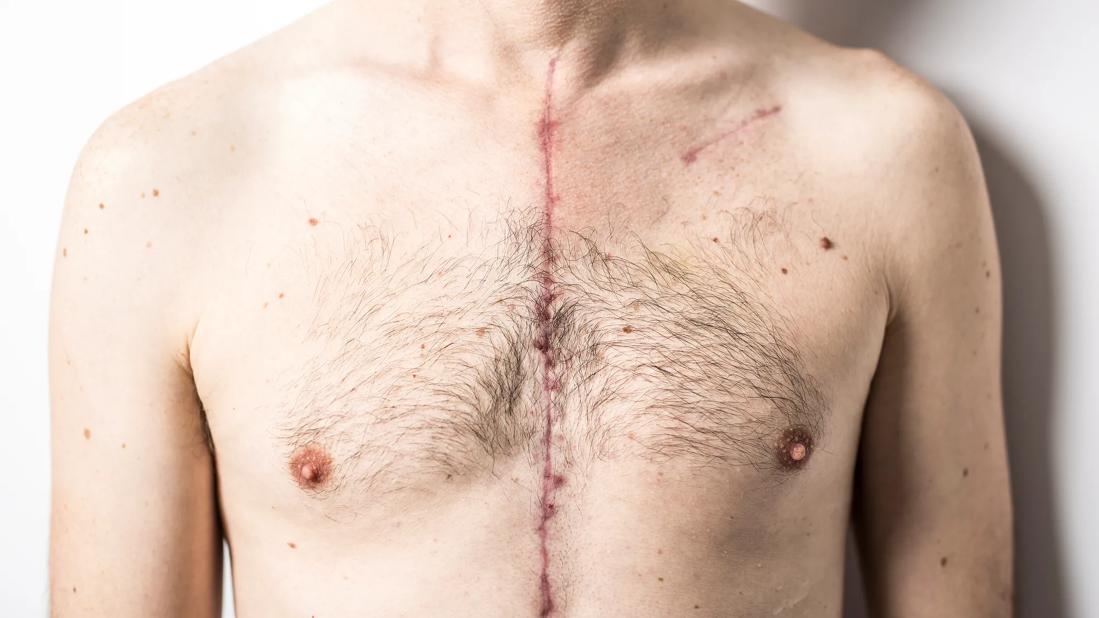Your scar will heal best if you keep the area clean, dry and covered for an appropriate amount of time

Everyone has different relationships with their open-heart surgery scar. Some like to show it off, while others like to keep it close to their chest. Regardless, your scar will always be a part of you in some way.
Advertisement
Cleveland Clinic is a non-profit academic medical center. Advertising on our site helps support our mission. We do not endorse non-Cleveland Clinic products or services. Policy
While a scar from an open-heart surgery is unavoidable, there are forms of aftercare that can help it heal as best as possible.
The size, location and appearance of your scar depend on the type of heart surgery you have and what incision your surgeon makes, says thoracic and cardiovascular surgeon Tarek Malas, MD.
Open-heart surgery scars are typically caused by:
Advertisement
Here are some ways to take care of your scar following heart surgery.
Your incision will be covered in a bandage while you’re in the hospital and removed by your healthcare provider after a few days. “Usually, you go home without a bandage,” Dr. Malas says.
After that, keep the area covered for two weeks with a small bandage or gauze as your scar starts to heal. Your doctor will give you instructions on how often you need to change your bandage (on average, you’ll need to change your bandage daily).
You also want to protect your scar from sun exposure. Keeping your scar covered will help it heal significantly and prevent any irritation.
To prevent infection and promote healing, keep your scar clean and dry. “For the first few weeks, don’t submerge in water or take long baths,” instructs Dr. Malas.
You can clean the area in the shower by using mild soap and warm water — and keep the water pressure low. Don’t pick or scrub at the scar. After, gently pat it dry with a soft towel.
In some cases, your doctor may recommend using a silicone gel or a silicone gel sheet (a soft, flexible adhesive) to help reduce the appearance of your scar, as well as reduce any initial irritation.
Silicone-based gel may help hydrate your scar tissue, flatten raised scars and reduce redness or discoloration. Silicone gel options are available as a prescription or over the counter. But talk with your provider prior to using this treatment strategy, as it’s not recommended for everyone.
To use, simply apply the gel or sheet after cleaning and drying your scar to help it retain moisture. Your doctor may also recommend using additional over-the-counter options like petroleum jelly.
Your open-heart surgery scar will heal and change in appearance, but it won’t go away completely. At first, your scar may appear red and thick. But at four to six weeks, you’ll notice that your scar has started to fade and soften.
“It’s after that six-week mark when it starts to fully heal,” Dr. Malas says.
Sometimes, healing can take up to three months. But in most cases, it should look very faint during its final phases of healing.
Dr. Malas also points out that some people may have keloid reactions, which is when your scar continues to grow and becomes larger than the original wound. “In those cases, your scar may remain more visible even after the passing of time,” he says.
Without any treatment, a keloid scar can continue to grow, becoming thicker, lumpy and change from red to brown. If you have a keloid scar, your healthcare provider can discuss treatment options, such as laser therapy or medication.
It’s important to follow up with your healthcare provider so they can keep an eye on your scar.
Advertisement
“It’s normal to have a little bit of redness but if the redness worsens, then that could potentially be a sign that you should see your doctor,” states Dr. Malas.
You should immediately see a healthcare provider if you notice:
“This could be a sign of infection,” he continues. “Sometimes, it’s normal for a scar to have a little bit of straw-colored, clear fluid to come out shortly after surgery. But it should stop with time.”
Coming home with a scar can feel like a huge change to your body. But remember that, in most cases, it will heal over time and become less visible.
More importantly, make sure to care for your scar and be gentle with it while your body takes its time to heal. And be sure to follow any aftercare recommendations from your healthcare provider or surgeon.
Advertisement
Learn more about our editorial process.
Advertisement

Fainting, heart palpitations and shortness of breath are just a few signs your heart may need help

It’s important to remember that not everyone heals at the same rate

Complications related to the implanted device leads may go unnoticed

Pacemakers steady heartbeat, ICDs reset the heart

Glitches are possible but unlikely

Early attention to skin wounds can help minimize their appearance later

Keep the area clean and monitor your incision site for discharge, odor or a change in appearance

Absolutely! In fact, in many ways, exercise is key to recovery

The best parenting style balances enforcing rules and showing plenty of love

Tips include cutting back on sugar, focusing on exercise and managing stress

It can be harder to let go when you’ve invested time, energy and emotions — but it might be the healthier choice long term